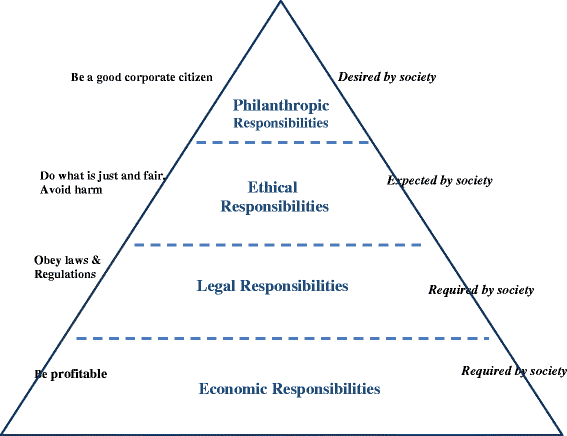3. Business Ethics and Social Responsibility
Social Responsibility
Over the last few decades, there has been a movement throughout the global business community to improve the world through smarter use of resources and giving back to communities. This movement is called corporate social responsibility (CSR). The concept is catching on at companies that range in size from small startups to large Fortune 500 corporations. In the following section, you will learn what social responsibility is and how it is a win-win for businesses and consumers.

What Is Corporate Responsibility?
Corporate responsibility refers to the idea that a business is given the opportunity and privilege to make the world a better place. This process can happen through a variety of methods, including the donation of funds, volunteerism, and implementation of environmentally friendly policies. It is up to each organization to determine the best way to demonstrate social responsibility.
Corporate social responsibility (CSR) has become a popular way for companies to improve their image and promote causes they believe in at the same time. Corporate social responsibility may involve focusing on the immediate community in which a company does business. However, there are some organizations that take it a step further and focus on more widespread global issues. For example, the shoe company TOMS has created a mission to make sure that every boy and girl in underprivileged countries has proper footwear. Blake Mycoskie, CEO of TOMS, has created a complete business model around social responsibility. Not stopping at shoes, the company now also helps with bringing fresh water to communities, as well as making birth safer for babies in developing nations.
The popularity of corporate social responsibility has only increased as millennials and Generation Z employees enter the workforce. Employees in these generations often care deeply about making a difference in the world in which they work. Whether they are buying products from brands that give back or promoting a similar activity in their own place of employment, the youngest of the workforce are making corporate social responsibility a priority.
Where Did Corporate Social Responsibility Originate?
Corporate social responsibility is not a new construct. One could go back hundreds of years and find examples of corporate philanthropy and social support. However, the earliest published book about the topic is:
Corporate Responsibility of the Businessman, published in 1953. This book introduced the concept of companies giving back as a form of investment in the future. This idea came from a generation that had survived some of the hardest times in our world and wanted to make it a better place for generations to come.
How Does Corporate Responsibility Benefit a Business?
There are many ways that corporate social responsibility can benefit a business and its objectives. Aside from being able to promote the causes that are closely connected to the values of the company, a business can improve its reputation exponentially.
Benefits of corporate social responsibility include many direct and indirect effects. Based on research from the Kellogg School of Management at Northwestern University, these can include:
- Improved perception by investors. If a company reports corporate social responsibility spending that exceeds the expectations of investors, this dollar amount is a sign that the company itself is in good financial standing. This perception results in positive stock returns and increased confidence by investors.
- Enhanced performance for going green. Researchers have found that when companies focus on eco-friendly efforts, the positive impact on operational performance heading into the second year is remarkable. Those that expand their efforts in more complex ways and in collaboration with industry standard-setting associations (such as LEED), or other eco-friendly companies, increase their performance even more.
- Contracting for success. In companies that tie their CEO’s salary to corporate social responsibility results, also known as contracting, the impact is felt even more. The value of the company increases while the bottom line of the business is maintained.
- The benevolent halo effect. When consumers understand the commitment that an organization must be socially responsible, its image becomes more positive. Customers actually perceive the company and its products in a different way because they expect a better experience.
- Consistency of efforts and partnerships. Researchers also found that socially responsible organizations were consistent with staying focused on the issues that mattered most to their employees and customers. A higher level of consistency of efforts prompted better results. There are some other benefits of being a socially responsible company. These may happen as a result of internal factors, as well as how closely matched the efforts are to the culture. Alison Robins, writer for OfficeVibe, explains that being socially responsible can help attract positive attention from outside of a company. Some examples include:
- Talent attraction. Many companies offer employees paid time off to participate in volunteer activities, including travel to other nations. Corporate social responsibility is often used as a recruitment tool to attract people who care about giving back to their communities and making changes that impact the world.
- Consumer influence. A major benefit of engaging in corporate social responsibility efforts is that consumers regularly check in with their favourite brands to see what they are doing, and they are influenced to make purchases so they can be part of this community. With the process of posting messages on social networks, entire movements can take off via the support of loyal consumers.
Archie Carroll’s Corporate Social Responsibility (CSR) Pyramid
(SOURCE: Fundamentals of Canadian Business: Canadian Edition by Pamplin College of Business and Virgina Tech Libraries is licensed under a Creative Commons Attribution-NonCommercial-ShareAlike 4.0 International License, except where otherwise noted.)
Carroll’s four-part definition of CSR was originally stated as follows: Corporate social responsibility encompasses the economic, legal, ethical, and discretionary (philanthropic) expectations that society has of organizations at a given point in time. This set of four responsibilities creates a foundation or infrastructure that helps to delineate in some detail and to frame or characterize the nature of businesses’ responsibilities to the society of which it is a part. This CSR definition forms a conceptual framework that includes the economic, legal, ethical, and philanthropic or discretionary expectations that society places on businesses at a given point in time. And, in terms of understanding each type of responsibility, it could be said that the economic responsibility is “required” of business by society; the legal responsibility also is “required” of business by society; the ethical responsibility is “expected” of business by society; and the philanthropic responsibility is “expected/desired” of business by society. As time passes what exactly each of these four categories means may change or evolve as well.
The four-part definition of CSR was originally published in 1979. In 1991, Carroll extracted the four-part definition and recast it in the form of a CSR pyramid. The purpose of the pyramid was to single out the definitional aspect of CSR and to illustrate the building block nature of the four-part framework. The pyramid was selected as a geometric design because it is simple, intuitive, and built to withstand the test of time. Consequently, the economic responsibility was placed as the base of the pyramid because it is a foundational requirement in business. Just as the footings of a building must be strong to support the entire edifice, sustained profitability must be strong to support society’s other expectations of enterprises. The point here is that the infrastructure of CSR is built upon the premise of an economically sound and sustainable business.
Carroll’s Pyramid of Corporate Social Responsibility:

The Pyramid of CSR is intended to be seen from a stakeholder perspective wherein the focus is on the whole not the different parts. The CSR pyramid holds that firms should engage in decisions, actions, policies and practices that simultaneously fulfill the four component parts. The pyramid should not be interpreted to mean that business is expected to fulfill its social responsibilities in some sequential, hierarchical fashion, starting at the base. Rather, business is expected to fulfill all responsibilities simultaneously. The positioning or ordering of the four categories of responsibility strives to portray the fundamental or basic nature of these four categories to business’s existence in society. As said before, economic and legal responsibilities are required; ethical and philanthropic responsibilities are expected and desired. The representation being portrayed, therefore, is that the total social responsibility of business entails the concurrent fulfillment of the firm’s economic, legal, ethical, and philanthropic responsibilities. Stated in the form of an equation, it would read as follows: Economic Responsibilities + Legal responsibilities + Ethical Responsibilities + Philanthropic Responsibilities = Total Corporate Social Responsibility. Stated in more practical and managerial terms, the CSR driven firm should strive to make a profit, obey the law, engage in ethical practices and be a good corporate citizen. When seen in this way, the pyramid is viewed as a unified or integrated whole.
The Financial Impact of the Triple Bottom Line
When examining the value of corporate social responsibility, one must understand the concept of the triple bottom line (TBL), which essentially measures the sustainability of an organization’s social responsibility efforts. The term includes three dimensions of a giving business—profits, people, and the planet. Without one of these factors, there cannot be a balance. According to economist Andrew Savitz, the triple bottom line “captures the essence of sustainability by measuring the impact of an organization’s activities on the world … including both its profitability and shareholder values and its social, human and environmental capital.”
The challenge with the TBL model is that while profits can be measured in dollars, and people can be measured in numbers, it can be difficult to measure the impact of social responsibility. Some argue that this task is dependent upon what is being measured. For example, if one is saving the rainforest, a reasonable unit of measurement could be acreage. Progress toward protecting this resource could be recorded as how many fewer acres have been forested and how many native (people) communities have been saved as a result of the intervention.
Another example could be a social cause, such as creating housing for single parents in poverty-stricken neighbourhoods in a specific city. The impact can be felt in terms of the additional housing that is created (built or rehabbed from existing homes), and the value that this effort brings to the neighbourhood. The number of people helped can be measured. The city’s rate of homelessness can be measured as it is reduced. Then, there are other equally important results of social responsibility that can be considered, such as the reduced rate of crime in areas with homeowners, and an increase in employment for those who own the homes. These indirect benefits have an impact on the company because it can eventually hire people from these areas of the city.
Businesses must be continually mindful of the image that they project to the world and be sure to align their corporate social responsibility campaigns with their culture. An authentic cause that is backed by all is far better than one that is dreamt up purely for the sake of marketing.

